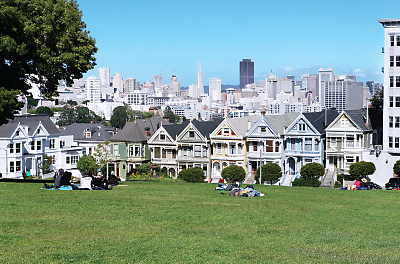San Francisco’s Painted Ladies Boast a Century of Admirers
Abstract
Regardless of whether this will be your first visit to San Francisco or your 20th, the “painted ladies” continue to delight the senses with their timeless vitality.
One of the symbols of San Francisco is the six rainbow-colored Victorian houses known as the “painted ladies.” They crown Steiner Street between Hayes and Grove streets.
When viewed from Alamo Square—the park across the street—they provide a stunning portrait, with the modern skyline of downtown San Francisco serving as a dramatic backdrop. This picture is perhaps the most beloved of all San Francisco panoramas and has made the painted ladies world famous.

The “painted ladies” at Alamo Square, with the modern San Francisco skyline as backdrop.
When you come to San Francisco for the annual meeting, you might want to consider paying a call on the painted ladies. They are captivating for a number of reasons.
First, they are all in the Queen Anne style, which was popular during the 1880s and 1890s. It was the most elaborate and eccentric of the Victorian architectural styles. Houses were asymmetrical and had steeply pitched, irregular roofs; cylindrical corner towers wearing “witch’s hat” turrets; fish-scale shingles; delicate porch posts; stained-glass windows, and other embellishments. Even though this style was popular during Queen Victoria’s reign in England, it was named after Queen Anne, an earlier English monarch who was associated with grandeur and elegance.
In addition, the houses have served as settings for commercials, the movie “Invasion of the Body Snatchers,” and the television show “Full House,” among others.
The ladies even hold appeal for residents who live near them. As one resident noted in her blog, “Despite having lived six blocks away from the Painted Ladies for years now, I’m still compelled to take a photo of them every time I find myself in Alamo Square. Every angle and time of day is like walking into a new stock photo. While the Golden Gate Bridge clearly wins as far as San Francisco icons go, the Painted Ladies have the added interest of people living inside them.”
Last year this blogger had occasion to call on the owners of one of the painted ladies, she reported. It was an older woman who had been a fashion model and a teacher of prisoners at San Quentin Prison just north of San Francisco. The woman’s family had been in San Francisco since the mid-1800s, and the house contained some notable treasures—for instance, a ticket from the opening of the Golden Gate Bridge and a photo of people gathered in Alamo Square while the city burned after the 1906 earthquake.
The painted ladies sometimes come up for sale. In 2010, and for the first time in a third-of-a-century, the oldest and largest was placed on the market for $4 million. Last spring, another was put up for sale for over $2 million. It had exquisite Victorian appointments such as bay windows, period light fixtures, gold-leaf trim, and soaring ceilings. The backyard contained old-growth redwood trees and lush ferns surrounding a brick patio. ■
Information about the painted ladies and other Victorian houses in San Francisco is posted at http://www.inetours.com/Pages/SFNbrhds/Victorian_Homes.html. Information about walking tours of San Francisco’s Victorian houses is posted at http://www.sfcityguides.org/.



